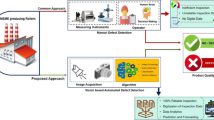We develop and study an automated method for the detection and classification of three types of technological defects in rolled metal products. The method is based on the ResNet50 neural network classifier, which makes it possible to recognize three classes of defects in the images of flat surfaces with a total accuracy of 95.8% on the basis of the analysis of experimental data with unbalanced numbers of images of different types. To train the classifier, we used about 88,000 images. It is shown that the application of the model developed on the basis of the ResNet50 neural network guarantees its excellent productivity, high quality of recognition, high speed, and high accuracy, which turns the proposed classifier into an effective tool for the solution of problems of engineering diagnostics and nondestructive testing aimed at the classification of defects on the surfaces of rolled metal products.



Similar content being viewed by others
References
F. Pernkopf and P. O'Leary, “Image acquisition techniques for automatic visual inspection of metallic surfaces,” NDT & E Int., 36(8), 609–617 (2003).
K. Song and Y. Yan, “A noise robust method based on completed local binary patterns for hot-rolled steel strip surface defects,” Appl. Surf. Sci., 285, Part B, 858–864 (2013).
Y. He, K. Song, H. Dong, and Y. Yan, “Semi-supervised defect classification of steel surface based on multi-training and generative adversarial network,” Opt. Lasers Eng., 122, 294–302 (2019).
H. Di, X. Ke, Z. Peng, and Z. Dongdong, “Surface defect classification of steels with a new semi-supervised learning method,” Opt. Lasers Eng., 117, 40–48 (2019).
K. Song, S. Hu, and Y. Yan, “Automatic recognition of surface defects on hot-rolled steel strip using scattering convolution network,” J. Comput. Inf. Syst., 10, 3049–3055 (2014).
S. Ghorai, A. Mukherjee, M. Gangadaran, and P. K. Dutta, “Automatic defect detection on hot-rolled flat steel products,” IEEE Trans. Instr. Measur., 62, 612–621 (2013).
P. Kostenetskiy, R. Alkapov, N. Vetoshkin, R. Chulkevich, I. Napolskikh, and O. Poponin, “Real-time system for automatic cold strip surface defect detection,” FME Transact., 47(4), 765–774 (2019).
M. Chu, R. Gong, S. Gao, and J. Zhao, “Steel surface defects recognition based on multi-type statistical features and enhanced twin support vector machine,” Chemometr. Intellig. Lab. Syst., 171, 140–150 (2017).
K. Xu, Y. Xu, P. Zhou, and L. Wang, “Application of RNAMlet to surface defect identification of steels,” Opt. Lasers Eng., 105, 110–117 (2018).
N. Neogi, D. K, Mohanta, and P. K. Dutta, “Review of vision-based steel surface inspection systems,” EURASIP J. Image Video Proc., 50(1), 1–19 (2014).
Y. Liu, K. Xu, and J. Xu, “An improved MB-LBP defect recognition approach for the surface of steel plates,” Appl. Sci., 9, 4222 (2019); https://doi.org/10.3390/app9204222.
L. Yi, G. Li, and M. Jiang, “An end-to-end steel strip surface defects recognition system based on convolutional neural networks,” Steel Research Int., 88(2), 60–68 (2017).
X. Tao, D. Zhang, W. Ma, X. Liu, and D. Xu, “Automatic metallic surface defect detection and recognition with convolutional neural networks,” Appl. Sci., 8(9), 1575 (2018); https://doi.org/10.3390/app8091575.
GOST 21014-88. Rolling of Ferrous Metals. Terms and Definitions of Surface Defects [in Russian], Izd. Standartov, Moscow (1989).
I. V. Konovalenko and P. O. Maruschak, New Digital Optical Methods for Technical Diagnostics of Materials and Structures [in Ukrainian], I. Pulyui Ternopil Nats. Tekh. Univ., Ternopil (2018).
B. E. Kapustiy, B. P. Rusyn, and V. A. Tayanov, “Peculiarities of application of statistical detection criteria for problems of pattern recognition,” J. Autom. Inform. Sci., 37(2), 30–36 (2005).
R. J. Kosarevych, B. P. Rusyn, V. V. Korniy, and T. I. Kerod, “Image segmentation based on the evaluation of the tendency of image elements to form cluster with the help of point field characteristics,” Cybernet. Syst. Anal., 51(5), 704–713 (2005).
Kaggle “Severstal: Steel Defect Detection. Can you Detect and Classify Defects in Steel?” (2019); https://www.kaggle.com/c/severstal-steel-defect-detection.
Y. Xu, R. Jia, L. Mou, G. Li, Y. Chen, Y. Lu, and Z. Jin, Improved Relation Classification by Deep Recurrent Neural Networks with Data Augmentation (2016); arXiv:1601.03651.
B. Rusyn, V. Korniy, O. Lutsyk, and R. Kosarevych, “Deep learning for atmospheric cloud image segmentation,” in: Proc. of the 11th Internat. Sci. Tech. Conf. on Electronics and Information Technologies (September 16–18, Lviv), Lviv (2019), pp. 188–191; https://doi.org/10.1109/ELIT.2019.8892285.
K. He, X. Zhang, S. Ren and J. Sun, “Deep residual learning for image recognition,” in: Proc. of the IEEE Conf. on Computer Vision and Pattern Recognition (CVPR), Las Vegas, NV (2016), pp. 770–778; https://doi.org/10.1109/CVPR.2016.90.
T.-Y. Lin, P. Goyal, R. Girshick, K. He, and P. Dollar, “Focal loss for dense object detection,” in: Proc. of the IEEE Internat. Conf. on Computer Vision (2017); https://doi.org/10.1109/ICCV.2017.324.
V. L. Mazur, A. I. Dobronravov, and P. P. Chernov, Prevention of Defects in Rolled Sheet Products [in Russian], Tekhnika, Kiev (1986).
Author information
Authors and Affiliations
Corresponding author
Additional information
Translated from Fizyko-Khimichna Mekhanika Materialiv, Vol. 56, No. 6, pp. 52–59, November–December, 2020.
Rights and permissions
About this article
Cite this article
Konovalenko, I.V., Maruschak, P.O. Classification of the Surface Technological Defects in Rolled Metal Products with the Help of a Deep Neural Network. Mater Sci 56, 779–788 (2021). https://doi.org/10.1007/s11003-021-00495-5
Received:
Published:
Issue Date:
DOI: https://doi.org/10.1007/s11003-021-00495-5




